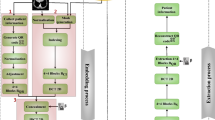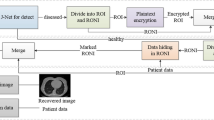Abstract
Data hiding is of the utmost importance for protecting the copyright of image content, given the widespread use of images in the healthcare domain. Presently, medical image security is important not only for protecting individual privacy but also for accurate diagnosis and treatment. In this paper, a deep learning-based segmentation for a medical data hiding technique with the Galois field is proposed. This technique uses a customised UNet3+ deep learning network to segment a medical image into a Region of Interest and a Non-Region of Interest. Through the proper spatial and transform-based embedding method, multiple marks are embedded into both parts of the medical image. In addition, encryption is utilised to provide additional security for protecting sensitive information when transmitted over an open channel so that the information cannot be retrieved. The extensive experimental results show that the proposed technique for medical images achieves a good balance between imperceptibility and robustness with high security. Further, the obtained results showed the superiority of our technique over state-of-the-art techniques, demonstrating that it can provide a reliable security solution for healthcare data.








Similar content being viewed by others
Data availability
Not applicable.
References
Singh OP, Singh AK, Zhou H (2022) Multimodal fusion-based image hiding algorithm for secure healthcare system. IEEE Intell Syst
Chatterjee A, Ahmed BS (2022) IoT anomaly detection methods and applications: a survey. Internet Things 19:100568
Fan C, Hu K, Yuan Y, Li Y (2022) A data-driven analysis of global research trends in medical image: a survey. Neurocomputing 518:308–320
Hossain MS, Cucchiara R, Muhammad G, Tobon DP, Saddik AE (2022) Special section on AI-empowered multimedia data analytics for smart healthcare. ACM Trans Multim Comput Commun Appl TOMM 18(1s):1–2
Singh AK, Anand A, Lv Z, Ko H, Mohan A (2021) A survey on healthcare data: a security perspective. ACM Trans Multim Comput Commun Appl 17(2s):1–26
Kumar J, Singh AK (2023) Copyright protection of medical images: a view of the state-of-the-art research and current developments. Multim Tools Appl 82:1–31
Zhang Y, Zhou W, Zhao R, Zhang X, Cao X (2022) F-TPE: flexible thumbnail-preserving encryption based on multi-pixel sum-preserving encryption. IEEE Trans Multim 25:1–15
Verma U, Sharma V (2022) Enhancing the security of medical images in telemedicine using region-based crypto watermarking approach. In: 12th international conference on cloud computing, data science & engineering. IEEE, pp 390–397
Balasamy K, Krishnaraj N, Vijayalakshmi K (2022) Improving the security of medical image through neuro-fuzzy based ROI selection for reliable transmission. Multim Tools Appl 81(10):14321–14337
Mendoza DM, Ramirez DN, Hernandez MC, Miyatake MN (2021) An improved ROI-based reversible data hiding scheme completely separable applied to encrypted medical images. Heal Technol 11(4):835–850
Gao G, Tong S, Xia Z, Wu B, Xu L, Zhao Z (2021) Reversible data hiding with automatic contrast enhancement for medical images. Signal Process 178:107817
Liu X, Lou J, Fang H, Chen Y, Ouyang P, Wang Y, Zou B, Wang L (2019) A novel robust reversible watermarking scheme for protecting authenticity and integrity of medical images. IEEE Access 7:76580–76598
Ma B, Li B, Wang XY, Wang CP, Li J, Shi YQ (2019) Code division multiplexing and machine learning based reversible data hiding scheme for medical image. Secur Commun Netw 2019:1–9
Bamal R, Kasana SS (2019) Dual hybrid medical watermarking using walsh-slantlet transform. Multim Tools Appl 78:17899–17927
Yang Y, Zhang W, Liang D, Yu N (2018) A ROI-based high capacity reversible data hiding scheme with contrast enhancement for medical images. Multim Tools Appl 77:18043–18065
Amrit P, Singh AK (2022) Survey on watermarking methods in the artificial intelligence domain and beyond. Comput Commun 188:52–65
Benvenuto CJ (2012) Galois field in cryptography. Univ Wash 1(1):1–11
Chen LC, Papandreou G, Kokkinos I, Murphy K, Yuille AL (2017) Deeplab: semantic image segmentation with deep convolutional nets, atrous convolution, and fully connected crfs. IEEE Trans Pattern Anal Mach Intell 40(4):834–848
Seo H, Huang C, Bassenne M, Xiao R, Xing L (2019) Modified U-Net (mUNet) with incorporation of object-dependent high-level features for improved liver and liver-tumour segmentation in CT images. IEEE Trans Med Imaging 39(5):1316–1325
Ronneberger O, Fischer P, Brox T (2015) U-net: convolutional networks for biomedical image segmentation, pp 234–241
Rayachoti E, Tirumalasetty S, Prathipati SC (2020) SLT based watermarking system for secure telemedicine. Clust Comput 23(4):3175–3184
[Online]. https://www.kaggle.com/datasets/tawsifurrahman/covid19-radiographydatabase
Parkhi OM, Vedaldi A, Zisserman A, Jawahar CV (2012) Cats and dogs. In: IEEE conference on computer vision and pattern recognition. IEEE, pp 3498–3505
Priyanka, Maheshkar S (2017) Regionbased hybrid medical image watermarking for secure telemedicine applications. Multim Tools Appl 76:3617–3647
Jyothsna KD, Singh P, Thakkar HK, Kumar N (2022) Robust and secured watermarking using Ja-Fi optimization for digital image transmission in social media. Appl Soft Comput 131:109781
Singh HK, Singh AK (2023) Using deep learning to embed dual marks with encryption through 3D chaotic map. IEEE Trans Consum Electron
Thabit R, Khoo BE (2015) A new robust lossless data hiding scheme and its application to color medical images. IDigital Signal Process 38:77–94
Fan C, Ding Q, Tse CK (2019) Counteracting the dynamical degradation of digital chaos by applying stochastic jump of chaotic orbits. Int J Bifurc Chaos 29(08):1930023
Nath Singh K, Singh OP, Singh AK, Agrawal AK (2022) EiMOL: a secure medical image encryption algorithm based on optimization and the Lorenz system. ACM Trans Multim Comput Commun Appl 19:1–19
Kumari M, Gupta S, Sardana P (2017) A survey of image encryption algorithms. 3D Res 8:1–35
Acknowledgements
This work is supported by research project order no. IES212111—International Exchanges 2021 Round 2, dt. 28 Feb 2022, under Royal Society, UK.
Author information
Authors and Affiliations
Corresponding author
Ethics declarations
Conflict of interest
The authors declare that they have no conflict of interest.
Additional information
Publisher's Note
Springer Nature remains neutral with regard to jurisdictional claims in published maps and institutional affiliations.
Rights and permissions
Springer Nature or its licensor (e.g. a society or other partner) holds exclusive rights to this article under a publishing agreement with the author(s) or other rightsholder(s); author self-archiving of the accepted manuscript version of this article is solely governed by the terms of such publishing agreement and applicable law.
About this article
Cite this article
Amrit, P., Singh, K.N., Baranwal, N. et al. Deep learning-based segmentation for medical data hiding with Galois field. Neural Comput & Applic (2023). https://doi.org/10.1007/s00521-023-09151-2
Received:
Accepted:
Published:
DOI: https://doi.org/10.1007/s00521-023-09151-2




